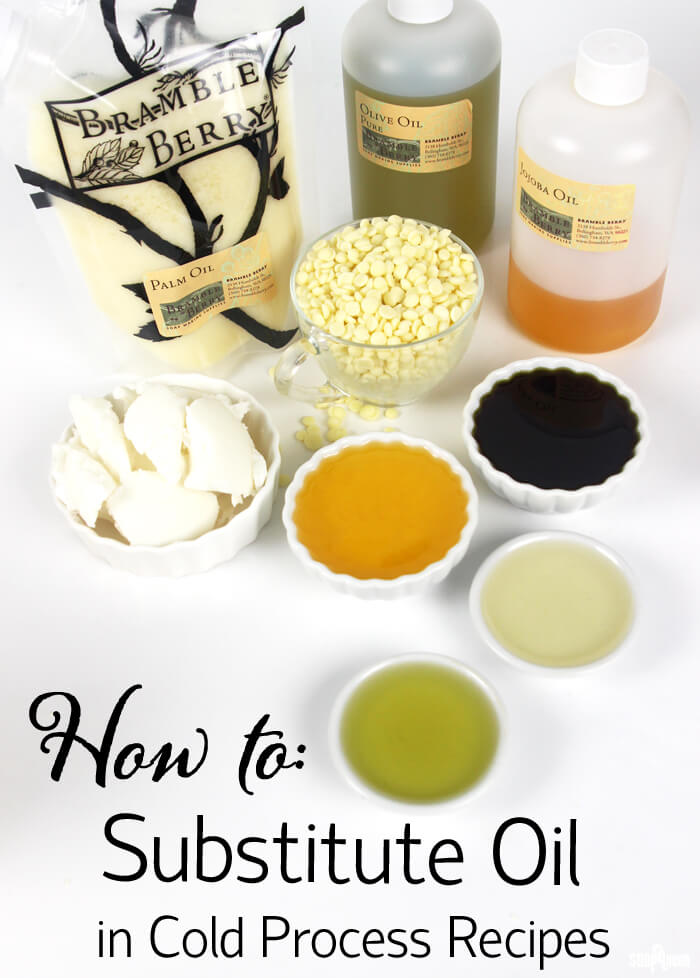 Selecting soap making oils and butters is a fun and personal process. Each oil and butter contributes various properties to the finished bar. For example, some oils may give a silky lather, while others may contribute extra moisturizing properties. Many soapers spend years perfecting their cold process recipes to create what they consider to be “the perfect bar.” The great thing about making your own soap is recipes can be altered depending on personal preference, or with what oils you have on hand. But be careful, not every oil substitution is made equally!
Selecting soap making oils and butters is a fun and personal process. Each oil and butter contributes various properties to the finished bar. For example, some oils may give a silky lather, while others may contribute extra moisturizing properties. Many soapers spend years perfecting their cold process recipes to create what they consider to be “the perfect bar.” The great thing about making your own soap is recipes can be altered depending on personal preference, or with what oils you have on hand. But be careful, not every oil substitution is made equally!
Before jumping into the complicated world of substituting oil in cold process recipes, I recommend reading the Free Beginner’s Guide to Soapmaking: Common Soapmaking Oils blog post. The key to substituting oils is to find an oil with similar properties in terms of how it behaves in soap. The Common Soapmaking Oils blog post provides a brief profile on each oil including what properties it contributes to soap, along with recommended usage rates.
In addition to this handy blog post, I also recommend becoming familiar with the Lye Calculator. The calculator is key for determining how much lye is necessary to turn the oils in your recipe into soap. For more information on how to use the calculator, check out the Using the Lye Calculator blog post. When substituting oils in a recipe, remember: always run the recipe through the Lye Calculator again. Even if you are using the same amount of oil, the amount of lye necessary to turn the oil into soap may be different. The Bramble Berry Lye Calculator is also available on your phone via the Soap Lye Calculator App! Available for both iPhone and Android, just search “Bramble Berry” to download.
The amount of lye necessary for the recipe depends on the saponification value of each oil. The saponification value (aka: SAP value) refers to the amount of lye it takes to turn 1 gram of oil into 1 gram of soap. The SAP value for each oil and butter may vary slightly depending on where it comes from. Because SAP values can vary, one lye calculator may give slightly different results than another calculator. When substituting oils in recipes, the SAP value can be helpful to identify oils that behave similarly. Keep in mind the SAP value does not reveal the characteristics (such as lather and moisture) that the oil gives to soap.
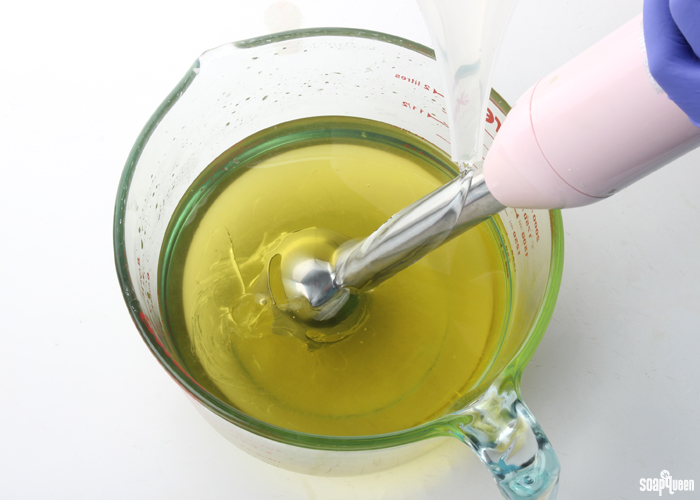 The amount of lye needed for the recipe depends on the type, and amount of oils used. Remember to always run your recipe through the Lye Calculator to ensure proper lye and water amounts.
The amount of lye needed for the recipe depends on the type, and amount of oils used. Remember to always run your recipe through the Lye Calculator to ensure proper lye and water amounts.
Some of the best cold process recipes contain a combination of both hard and soft oils. What is a hard oil, and what is a soft oil? A hard oil or butter is solid at room temperature. Some of the most common hard oils include palm oil and coconut oil. Butters such as cocoa, shea, avocado, coffee and mango are a mix, but most consider them to be hard oils as well. In order to use these oils in cold process soap, they must be melted to a liquid state. Hard oils and butters contribute firmness to the final bar. If the recipe does not contain enough hard oils, the bar may be soft or sticky to touch.
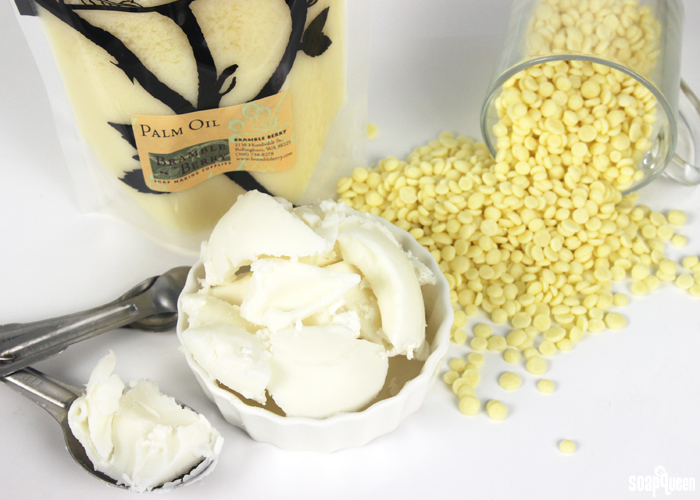 Shown above are palm oil, shea butter and cocoa butter. All three are hard oils because they are solid at room temperature.
Shown above are palm oil, shea butter and cocoa butter. All three are hard oils because they are solid at room temperature.
Soft oils refer to oils that are liquid at room temperature. The list of soft oils is expansive, but some of the most popular include olive oil, canola oil, rice bran oil, avocado oil, and sweet almond oil. Soft oils contribute skin-loving properties to soap, and ensure it is not brittle. Soft oils also help prevent the soap from cracking.
When substituting an oil from a recipe, the first step is to consider what kind of oil it is. Is it hard, or is it soft? In general, hard oils should replace hard oils, and soft oils should replace soft oils. Doing so will help maintain the balance of hard and soft oils. Once you’ve narrowed down the texture of the oil, consider what the oil does for the recipe. Does it give the soap firmness, moisture, or contribute to the lather? Selecting an oil with similar soaping qualities helps retain the properties of the original recipe. Of course these guidelines are not absolute; For example, if you want to soften the original recipe, you may replace a butter with a soft oil.
Remember, there are no concrete rules when it comes to substituting oils in cold process recipes. Let’s take a look at the Espresso Shot Cold Process recipe below, which features cocoa butter. The percentage of each oil and butter are listed as well.
Espresso Shot Cold Process Recipe:
16.5 oz. Olive Oil 30%
13.7 oz. Palm Oil 25%
13.7 oz. Coconut Oil 25%
2.7 oz. Hazelnut Oil 5%
2.7 oz. Coffee Butter 5%
5.5 oz. Cocoa Butter 10%
7.7 oz. Sodium Hydroxide
18.1 oz. distilled water
This recipe contains the normal 20-30% of olive oil, palm oil and coconut oil. It contains 10% of cocoa butter, which is an extremely hard butter. Coffee butter is also a hard oil, but is slightly softer than cocoa butter. Hazelnut oil is light, non-greasy liquid oil that is great for dry skin. You’re ready to recreate this recipe, but realize you don’t have any cocoa butter. What else could you use?
The cocoa butter makes this soap firm. Other oils that give this recipe firmness are the palm oil and coffee butter. One option is to slightly increase the palm oil to 30%, and increase the coffee butter to 10%; increasing these oils will make up for the firmness you lose by omitting the cocoa butter. Another option would be to increase the palm to 30% and the hazelnut oil to 10%. This option will result in a slightly softer bar. Palm kernel flakes would also make a great substitution. However you choose to tweak the recipe, don’t forget to run the new oil amounts through the Lye Calculator! There are many more substitution options for this recipe. The key to substitutions is to consider what qualities the oil gives to the soap, and how it interacts with the other oils in the recipe.
Substituting Palm, Olive & Coconut Oils:
Palm, olive and coconut oil are the three most common soap making oils. Many recipes revolve around these three oils. Palm oil contributes firmness, coconut oil provides cleansing properties and olive oil gives the bar softness and skin-loving attributes. The combination of these three oils creates a bar that is firm, cleansing and moisturizing. A very common soap recipe involves using 30% olive, coconut and palm oils with an additional 10% extra oil. Looking to substitute one of these oils? Here are my recommendations and tips:
- Replacing Palm Oil: Palm oil gives soap firmness and is a secondary lathering agent. It makes soap easier to unmold, and contributes to a thicker trace. When replacing palm in a recipe, you’ll want to find an oil/butter that contains high amounts of palmitic or stearic acid. If you are looking to replace palm oil, tallow is a popular option. Tallow is a rendered form of beef or mutton fat. Tallow gives soap firmness, and a creamy lather. It is not particularly cleansing, and because of this it is often combined with coconut oil. For more information on tallow, click here. Another option when formulating a recipe without palm, is to use other hard oils such as butters or palm kernel flakes. Keep in mind, palm oil can be used up to 30% in cold process recipes, while butters and palm kernel flakes should be used at 15% or below. Adding sodium lactate to your palm free recipe helps the soap harden faster, making soft recipes easier to unmold. Sodium lactate should be used at a rate of 1 tsp. per pound of oils.
- Replacing Coconut Oil: Coconut oil is a unique soap making oil. In addition to adding firmness, it gives the recipe cleansing properties and a full lather. Because of its cleansing nature, using more than 30% coconut oil can result in soap that is drying to the skin. In my opinion, coconut oil is the trickiest oil to substitute. If you are looking to formulate a recipe without coconut oil, palm kernel flakes can help. I recommend using 15% or less of palm kernel flakes in your cold process recipe.
- Replacing Olive Oil: Olive Oil is extremely gentle, and gives soap a mild and creamy lather. Olive oil can be used up to 100% in cold process recipes; soap made with 100% olive oil is referred to as castile soap. Good substitutes for olive oil include rice bran oil and canola oil. Both rice bran and canola oil contribute a creamy lather, very similar to olive oil. Rice bran oil can be used up to 100%. while canola is recommended at 40% or below. Pomace olive oil is very different from pure olive oil. Pomace olive oil is made by extracting the last bits of oil and fat from the paste left over from pressing extra virgin olive oil. Pomace olive oil speeds up trace more so than pure olive oil, and adds hardness.
Below is a list of common soap making oils, along with oils that have similar properties. Keep in mind that while oils may have similar soaping characteristics, they may have different usage rates. For example, if you need to make soap without coconut oil, palm kernel flakes also give cleansing and firmness. But, palm kernel flakes have a slightly lower usage rate than coconut oil. While these oil substitutions will maintain the basic makeup of the recipe, some oils have unique properties that cannot be substituted, like castor oil. And of course, don’t forget to always run your recipe through the Lye Calculator! If you make a substitution, we recommend making a small test batch of soap. That way you can see how the soap feels with the new ingredient and make adjustments if necessary.
Common Soap Making Oil Substitutes
Apricot Kernel Oil: Sweet Almond Oil, Hazelnut Oil
Avocado Oil: Chia Seed Oil, Sweet Almond Oil
Avocado Butter: Shea Butter, Mango Butter
Canola Oil: Olive Oil, Rice Bran Oil
Castor Oil: No substitute
Cocoa Butter: Beeswax, Shea Butter, Palm Kernel Flakes
Coconut Oil: Palm Kernel Flakes, Tallow
Coffee Butter: Avocado Butter, Shea Butter
Chia Seed Oil: Sweet Almond Oil, Avocado Oil
Grapeseed Oil: Olive Oil, Hazelnut Oil
Hazelnut Oil: Grapeseed Oil, Apricot Kernel Oil, Hemp Seed Oil
Hemp Seed Oil: Avocado Oil, Hazelnut Oil
Jojoba Oil: Meadowfoam Oil
Mango Butter: Avocado Butter, Shea Butter
Meadowfoam Oil: Jojoba Oil
Olive Oil: Rice Bran Oil, Canola Oil, Grapeseed Oil
Palm Oil: Tallow, Palm Kernel Flakes
Palm Kernel Flakes: Palm Oil, Coconut Oil
Peanut Oil: Olive Oil, Canola Oil
Rice Bran Oil: Olive Oil, Canola Oil
Safflower Oil: Canola Oil, Sunflower Oil
Shea Butter: Avocado Butter, Mango Butter
Sunflower Oil: Olive Oil, Safflower Oil
Sweet Almond Oil: Apricot Kernel Oil, Avocado Oil, Chia Seed Oil
Tamanu Oil: Neem Oil, Pumpkin Seed Oil
Remember, if you do sub out any oils in your soapmaking, always run it through a lye calculator!
When you substitute oils in a recipe, what steps do you take? It’s such a complicated and personal process, and everybody does it a little differently. I would love to hear any tips or tricks you may have!
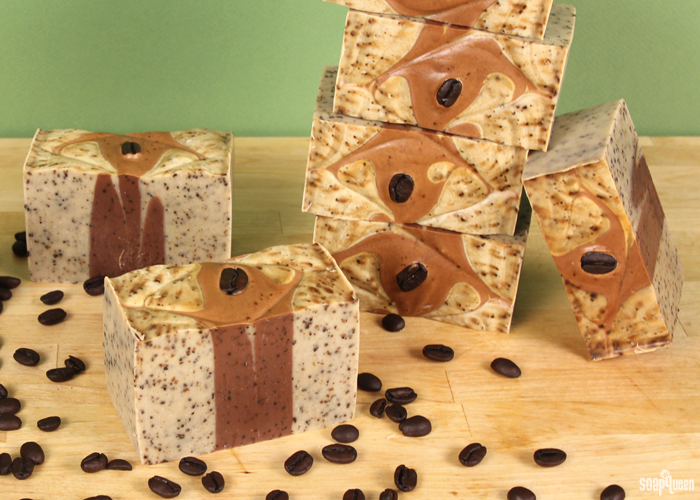
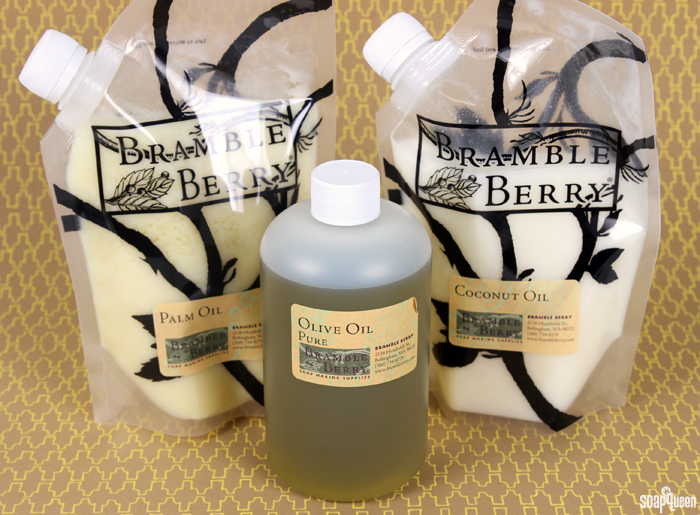
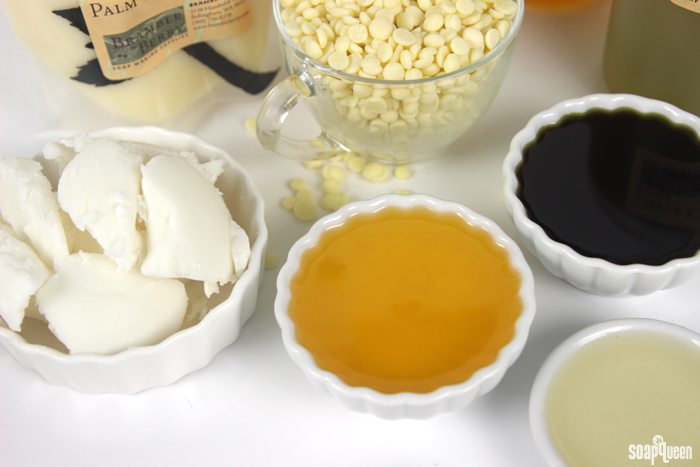




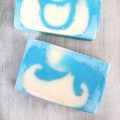
Hello,
I have a question about Shea Oil ( Not Butter ) Can I use this in soap making? If so which oil would you say it is most like or can be a substitute of.
Thankyou for your help 🙂
You can use shea oil in soap! We recommend it at 10% or less in your recipe. It’s fairly thick, so it can be used in place of other thick oils like olive or canola. 🙂
Remember to run your recipe through the Lye Calculator after any substitutions: https://www.brambleberry.com/Pages/Lye-Calculator.aspx
-Kelsey with Bramble Berry
Shea oil: https://www.brambleberry.com/Shea-Oil-Liquid-P4892.aspx
Is walnut oil an acceptable substitute for olive oil? If not, which oil(s) is it similar to?
We haven’t worked with walnut oil so I’m not very familiar with it! However, this blog from Swift Crafty Monkey says it’s similar to hazelnut and grapeseed oil: http://swiftcraftymonkey.blogspot.com/2014/01/what-do-you-want-to-know-whats-up-with_6.html
Hazelnut oil: https://www.brambleberry.com/Hazelnut-Fixed-Oil-P3197.aspx
Grapeseed oil: https://www.brambleberry.com/Grapeseed-Oil-P6029.aspx
-Kelsey with Bramble Berry
Hello,
First of all, I’d like to thank you for this post, I have come to it many times, and come away creating successful recipes. I was wondering whether you know of a substitute for sesame oil?in the recipe I am looking at I will be using Palm oil, palm kernel oil, olive oil and cacao butter.
Thank you!
So glad you’re enjoying this post Tick! Sweet almond or avocado oil is a good substitute for sesame oil. They have a similar lightweight feeling. 🙂
Sweet almond oil: https://www.brambleberry.com/Sweet-Almond-Oil-P3205.aspx
Avocado oil: https://www.brambleberry.com/Avocado-Oil-P3198.aspx
-Kelsey with Bramble Berry
Hello. You guys are so helpful! Do you have any recommendations on how to add some hemp seed oil to this recipe ?247 g Olive oil
238g coconut oil
165 g Palm oil
124 g Shea butter
42 g Castor oil
Absolutely! You can use hemp seed up to 20% in your recipe. If you want your recipe softer, you can reduce the amount of coconut oil and replace it with hemp seed. If you like the consistency now, you can reduce the olive oil and replace with hemp seed. 🙂
You can recalculate your recipe using our Lye Calculator: https://www.brambleberry.com/Pages/Lye-Calculator.aspx
This post on Soapy Math is really helpful as well: https://www.soapqueen.com/bath-and-body-tutorials/tips-and-tricks/math-soapers/
And this post tells you how much of each oil to use: http://www.soapqueen.com/bath-and-body-tutorials/tips-and-tricks/free-beginners-guide-to-soapmaking-common-soapmaking-oils/
-Kelsey with Bramble Berry
Hello,
So I am looking for a recipe that contains goat’s milk, rose hip carrier oil, olive oil, lye, and dried rose pedals. I am very new to soap making and only made soap a couple of times so I was wondering if I could get a little help with the ratios so I don’t make a mistake. I am always afraid of using the lye and messing up so I am hoping to also find a full proof recipe or guide to making different kinds of soaps. Thanks!
Absolutely, I can definitely help you out! Are you just wanting to use olive oil and rosehip oil in your recipe? Let me know. 🙂
-Kelsey with Bramble Berry
I have a receipt that calls for canola oil in cold process soap on the calculator not sure how to determine is it high oleic or rapiseed
I would recommend checking with the manufacturer! They should know if it’s high oleic or not. Our canola oil is high oleic. 🙂
Canola oil: https://www.brambleberry.com/Canola-Oil-High-Oleic-P5548.aspx
-Kelsey with Bramble Berry
Hi! I would love to start making my own soap. I am looking for a recipe which will give me a very hard, long lasting bar of soap which will also be conditioning. I was thinking of using your Lots Of Lather recipe, but I was wondering if it would help the moisturizing properties to add a few oz. of cocoa butter? I have also read that it will contribute to a harder bar. I just don’t want to mess up a perfectly balanced recipe!
Thanks! 🙂
Hi Vivian!
You can definitely add cocoa butter if you like! It adds moisturizing and firming properties to the bar. It can be added at 15% or less in the recipe. For the Lots of Lather Recipe, you can decrease the coconut or palm to account for the cocoa butter, or the olive oil. Decreasing the olive oil and adding more cocoa butter will make it more firm. You may want to make some small test batches with different amounts to see what you like. Just make sure to run it through the Lye Calculator after any substitutions. 🙂
Cocoa butter: https://www.brambleberry.com/Organic-Cocoa-Butter-Cubes-P6365.aspx
Lots of Lather Recipe: http://www.soapqueen.com/bath-and-body-tutorials/cold-process-soap/my-favorite-cold-process-recipes-2/
Lye Calculator: https://www.brambleberry.com/Pages/Lye-Calculator.aspx
-Kelsey with Bramble Berry
Great!
The only other thing I am worried about, is that I read that adding a higher percentage of ‘hard’ oils, can make something called a false trace. I don’t know if this ruins the soap or how to prevent this. Do you think that adding, say between 5-10% of cocoa butter could cause this?
Also, I am planning to scent my soap. Should I get deodorized cocoa butter so that it isn’t noticeable, or do you think it wouldn’t make a big difference in a small quantity like that?
And, I’m going to be adding essential oils for the scent. Should I add that when I calculate the lye?
Thanks for you patience! I know I have a lot of questions, and I hope I don’t overwhelm you!
Vivian 🙂
No worries Vivian, we’re happy to help! False trace is caused by lower temperatures. So, if your lye is room temperature or cooler, it can harden the butter and hard oils in your recipe. To prevent that, we recommend soaping around 115-120F. That will ensure everything stays melted and you have time to work with your design. 🙂
Read more about false trace here: https://www.soapqueen.com/bath-and-body-tutorials/tips-and-tricks/spot-prevent-false-trace/
If you’re not a fan of the natural chocolatey scent of cocoa butter, deodorized cocoa butter would be a good idea! It won’t scent the final bars.
Deodorized cocoa butter: https://www.brambleberry.com/Deodorized-Cocoa-Butter-P3199.aspx
Essential oils are considered additives, so you don’t need to calculate them in your oil weight! Instead, you can add them afterward based on the total weight of your soap. 🙂
Fragrance Calculator: https://www.brambleberry.com/Pages/Fragrance-Calculator.aspx
-Kelsey with Bramble Berry
Thanks so much, Kelsey!
I only have one more question. 🙂 I am trying to find a good thermometer to use for the process. Would a basic candy thermometer work, or would you recommend something different?
Thanks,
Vivian
You can use a candy thermometer as long as it’s stainless steel! Aluminum can react with the lye and create toxic fumes, so stainless steel is best. Just make sure to dedicate that thermometer to soap and not use it for food once it’s been used for soap. We love using infrared thermometers as they’re easy to use as you make the soap. 🙂
Infrared thermometer: https://www.brambleberry.com/Infrared-Thermometer-P6087.aspx
-Kelsey with Bramble Berry
Do you have laminated cards/pages for sale with soap making tips such as the substitution list above? Thank you!
We have a PDF with common oils, their shelf lives and usage rates! You can find that here: http://images.soapqueen.com.s3.amazonaws.com/GuidetoCommonSoapmakingOils_V1-00.pdf
It’s really nice to print out and keep on hand. 🙂
We don’t have cards for this substitution list, but we’ll definitely keep that in mind. Thanks for your suggestion!
-Kelsey with Bramble Berry
Hi dear,
Viet Nam is my country. We have plenty of Gac (Momordica Cochinchinensis) oil here. I’d like to use this oil for soap making and hardly run it through Soapcalc.net since it is not listed there. Do you have any suggestion?
We haven’t worked with gac oil so I’m not entirely sure what to input in the Lye Calculator. Do you know the SAP value of the oil? If you can get the SAP value, you can compare it to this list and plug it into our Lye Calculator: http://www.soapqueen.com/bath-and-body-tutorials/tips-and-tricks/free-beginners-guide-to-soapmaking-common-soapmaking-oils/
Lye Calculator: https://www.brambleberry.com/Pages/Lye-Calculator.aspx
-Kelsey with Bramble Berry
can i leave castor oil OUT if I don’t have it there is no substitute in your list
You can leave it out if you like! Castor oil is a unique texture that adds bubbles to your soap and there is no direct substitute for it. You can use coconut oil up to 33% to add lathering properties to the bar. 🙂
-Kelsey with Bramble Berry
what can i use in a soap with castor oil and lye
Hi Rhonda! Are you wanting to make a soap with 100% castor oil? Let me know. 🙂
-Kelsey with Bramble Berry
I have a recipe that calls for olive oil, coconut oil, sunflower oil, and cocoa butter. Do you think I can I use avocado oil in place of sunflower oil if I run it through a lye calculator?
You can use avocado in place of sunflower oil! They both have a lightweight texture, so they can be substituted. We recommend using avocado oil at 12.5% or less in the recipe. 🙂
Lye Calculator: https://www.brambleberry.com/Pages/Lye-Calculator.aspx
Avocado oil: https://www.brambleberry.com/Avocado-Oil-P3198.aspx
-Kelsey with Bramble Berry
Hi, im a beginner at soaping and would like to make some sugar scrub cubes using M&P, the recipe I have calls for shea butter. Could I substitute this for coconut oil?
Thank you xx
Hi Kerrie!
You can use coconut oil in place of the shea butter! Shea butter is a bit more firm than coconut oil, so the cubes may be a bit softer. They should still feel great though. 🙂
-Kelsey with Bramble Berry
I have a recipe for Goats milk soap that calls for. 4lbs olive oil, 2lbs8oz coconut oil, 1lbs8oz palm oil, 1/2lbs goats milk, 2and1/2lbs water, 473grams sodium hydroxide, I love it but recently I was given a 50lb box of hard palm kernel oil, can I use this up some how or was I given this cause it’s not good for soaps? If you could help me adjust the recipe I’d be grateful! Thanks for your helpful post!
Hi Emily!
Is the palm kernel oil in flake form or solid form? Let me know and I can give you some tips for working it into your recipe! 🙂
-Kelsey with Bramble Berry
Thank you so much for this post. I am nut and coconut allergic. I was looking for just such a post as this to guide me in substituting ingredients. I don’t know if using these oils on my skin would be harmful to me or not but I’m also not sure I want to find out the hard way!
You’re very welcome, glad you found the post helpful! 🙂
-Kelsey with Bramble Berry
Can I use Sunflower oil in place of olive oil, my recipe normally is olive, palm, coconut and shea butter but i’d like to swap out the olive for sunflower. Does it behave the same. Thanks
You can use sunflower oil instead of olive oil! It is lighter than olive oil so it will feel a bit different on the skin. I would recommend making a small test batch with the sunflower oil to see if you like the way it feels in your bar. 🙂
Sunflower oil: https://www.brambleberry.com/Sunflower-Oil-P3208.aspx
-Kelsey with Bramble Berry
Hi, Kelsey!
I live in Venezuela, so I can’t find this oils easily. I just have coconut oil, soy oil and some sesame oil. I’ve made some batches already, but they turn out a little hard and not so skin gentle. I mean, they don’t itch but they don’t moisturize either. What do you recommend? I was thinking in some cow milk, honey and oat to add some good properties to my soap, but I don’t know If that will work with these oils.
Thank you!! I love your page.
Hi Shirley!
Thank you, glad you love the blog!
I’m wondering if it may be the coconut oil. Coconut oil adds cleansing and lathering properties to the recipe, but at a higher percentage it can be a bit drying. What percentage are you adding the coconut oil at? Let me know and I can give you some tips to make the bars a bit softer. 🙂
Read more about soapmaking oils and their properties here: http://www.soapqueen.com/bath-and-body-tutorials/tips-and-tricks/free-beginners-guide-to-soapmaking-common-soapmaking-oils/
-Kelsey with Bramble Berry
Is there a substitute for Camellia Oil, also known as Tea Seed Oil? I can’t find any information on it. Thanks!
Hi Maddie!
Absolutely! Camellia oil, or green tea seed oil, is a lightweight liquid oil. Some similar oils include avocado, chia seed, sweet almond and sunflower oil. They are lightweight and moisturizing as well. 🙂
Green tea seed oil: https://www.brambleberry.com/Green-Tea-Seed-Oil-P5927.aspx
-Kelsey with Bramble Berry
Avocado oil: https://www.brambleberry.com/Avocado-Oil-P3198.aspx
Chia seed oil: https://www.brambleberry.com/Chia-Seed-Oil-P5612.aspx
Sweet almond oil: https://www.brambleberry.com/Sweet-Almond-Oil-P3205.aspx
Sunflower oil: https://www.brambleberry.com/Sunflower-Oil-P3208.aspx
Great Post as always! Im getting ready to make my first batch of CP soap and i have coconut oil, olive oil, canola oil, castor oil, shea butter, palm kernel flakes, cocoa butter, mango butter and some amount of rice bran oil but i forgot to order palm oil and im out of the country and based on circumstances wont have access to it. I see in your post it says that it can be replaced at a lower % with palm kernel flakes but the makeup is so different from palm oil. Palm kernel is more like coconut oil than palm oil based on research. Are there any other replacements that i can use (listed above) and do you have any recipes that are tried and true i can follow that doesn’t include palm oil but has what i listed above? it would be a tremendous help if you could assist me in figuring this out so i dont pull out all my hair. Please help
Hi Kim!
I must have missed this question. I am so sorry about the delayed response.
Palm oil adds some great firmness to your soap, and there is no direct replacement for it. You can add certain oils and butters to help firm your soap up though! For instance, adding a hard butter, like cocoa butter up to 15%, can harden the bars. You can also add coconut oil or tallow up to 33%. 🙂
Read more about common oils and what properties they add to soap here: http://www.soapqueen.com/bath-and-body-tutorials/tips-and-tricks/free-beginners-guide-to-soapmaking-common-soapmaking-oils/
This post on substituting oils has some great information too: http://www.soapqueen.com/bath-and-body-tutorials/tips-and-tricks/how-to-substitute-oil-in-cold-process-recipes/
Sodium lactate is helpful as well. It helps the bars unmold more quickly. You can add 1 tsp. of sodium lactate per pound of oils to your cooled lye water. Read more in the Sunday Night Spotlight: Sodium Lactate: http://www.soapqueen.com/bramble-berry-news/sunday-night-spotlight-sodium-lactate/
Here are some links to palm-free recipes you may like:
Palm Free Vertical Twist: http://www.soapqueen.com/bath-and-body-tutorials/cold-process-soap/palm-free-vertical-twist-tutorial/
Palm Free In The Pot Swirl: http://www.soapqueen.com/bath-and-body-tutorials/cold-process-soap/a-palm-free-in-the-pot-swirl/
Formulating Cold Process Recipes: http://www.soapqueen.com/bath-and-body-tutorials/tips-and-tricks/formulating-cold-process-recipes/
Hope that helps! 🙂
-Kelsey with Bramble Berry
Can i just use olive oil, coconut oil castor oil and shea butter and not to use palm oil?
You can! That combination will make a great bar of soap. To make the bars a bit harder, you can use coconut oil up to 33% and shea butter up to 15%. 🙂
Read more about common soapmaking oils and how to use them in this post: http://www.soapqueen.com/bath-and-body-tutorials/tips-and-tricks/free-beginners-guide-to-soapmaking-common-soapmaking-oils/
-Kelsey with Bramble Berry
Why can’t castor oil be substituted? I guess what I’m really wondering is, is it possible to make a shampoo bar w/o castor oil? I have tallow, coconut oil, olive oil and everything to make my first batch of CP soap (lye, molds, stick blender, safety gear…). Actually I’ll probably make a simple tallow soap for my first batch, but am very intrigued by the idea of a shampoo bar. I’ve been washing my hair with baking soda, rinsing with ACV for a couple few years now, but my daughters won’t. I think they might be open to trying a shampoo bar (esp. if it lathers & even smells nice!). Any thoughts or do I have to “bite the bullet” and order some castor oil?
Thanks!
(PS, your site was recommended to me by some fellow homeschoolers at our annual craft fair this past fall. 🙂 )
Hi Julie!
Castor oil is a unique ingredient! It has a thick, slightly sticky texture. In soap, it adds cleansing and bubbling properties. We haven’t found another oil that acts quite like it.
In shampoo bars, it helps to cleanse and moisturize the hair. It also makes the bars a bit softer so they spread easily on the hair. You can leave it out of your recipe if you like! Coconut oil adds great cleansing and bubbling properties, and can be used up to 33%.
To help add some moisture and softness back into the bars, you can add olive oil at a higher percentage (40% or so), then the rest of the recipe can be tallow.
The perfect shampoo bar for you will also depend a lot of your hair type! If your hair is on the oilier side, you can add more tallow and coconut oil to the recipe to help firm it up. If your hair is more dry, you may need more olive oil to help add some moisture to the hair. A couple of small test batches would be helpful. That way you can find your perfect recipe. 🙂
Read more about formulating cold process recipes here: http://www.soapqueen.com/bath-and-body-tutorials/tips-and-tricks/formulating-cold-process-recipes/
And more about common soapmaking oils here: http://www.soapqueen.com/bath-and-body-tutorials/tips-and-tricks/free-beginners-guide-to-soapmaking-common-soapmaking-oils/
I’ll include some shampoo bar recipes below as well. They have some good tips and tricks for making shampoo bars that may be helpful for you. 🙂
Sudsy Shampoo Bars: http://www.soapqueen.com/bath-and-body-tutorials/cold-process-soap/sudsy-shampoo-bars/
Invigorating Shampoo Bars: http://www.soapqueen.com/bath-and-body-tutorials/cold-process-soap/invigorating-shampoo-bars/
-Kelsey with Bramble Berry
Wow – a wealth of information! Thank you so much! My friends were right. 🙂
You’re welcome Julie! 🙂
-Kelsey with Bramble Berry
What might be a good sub for argan oil, both in soaps and lotions?
Thx
Hi Amber!
Green tea seed oil and meadowfoam oil would be good substitutes! They have a similar lightweight feel to argan oil. Make sure to run that recipe through the Lye Calculator after any substitutions! A small test batch would be helpful as well. 🙂
Green tea seed oil: https://www.brambleberry.com/Green-Tea-Seed-Oil-P5927.aspx
Meadowfoam oil: https://www.brambleberry.com/Meadowfoam-Oil-P4978.aspx
Lye Calculator: https://www.brambleberry.com/Pages/Lye-Calculator.aspx
-Kelsey with Bramble Berry
You have the best soap making website and you’re always so kind to the people commenting. Thank you for what you do:)
I’m following a lady’s recipe for hp db method and it calls for Olive, coconut, palm, castor, and sunflower. Sunflower oil is the only one I don’t have. Do you have a recommendation for substituting, or could I just add more of the others to make up for the sunflower?
Also, do you recommend testing it with a ph tester?
I’m completely new to soap making! I made my first batch of soap last week using the cp method. I feel like I have so much to learn. And I totally stink at figuring out the percentages and ounces for recipes. I should’ve paid more attention in math class! 🙂 Would love to create my own recipes but for now I’m just going to follow tried and tested recipes from Soap making sages…Like yourself.
Thanks again,
Nikkoal
Hi Nikkoal!
You’re very welcome, thank you for your sweet comment! We are more than happy to help. 🙂
For the sunflower oil, you can replace it with safflower oil. If you don’t have that on hand, you can increase the amount of olive oil in your recipe to cover it. That will feel great in the soap. Just make sure to run that recipe through the Lye Calculator again after any substitutions: http://www.soapqueen.com/bath-and-body-tutorials/cold-process-soap/using-the-bramble-berry-lye-calculator-2/
For hot process soap, we love having pH strips on hand. That way you can test your soap to make sure it’s around 8-10 before plopping it into the mold. We used them in the Lavender and Lemongrass Hot Process Soap video: http://www.soapqueen.com/bath-and-body-tutorials/lavender-lemongrass-hot-process-soap-on-soap-queen-tv/
I’m not the best at math either! I think using tried and true recipes is a great way to start. Then, once you have a few recipes under your belt, you can start experimenting with different oils and additives. We have some helpful posts when you’re ready for that. I’ll include links below. 🙂
Free Beginner’s Guide to Soapmaking: Common Soapmaking Oils: http://www.soapqueen.com/bath-and-body-tutorials/tips-and-tricks/free-beginners-guide-to-soapmaking-common-soapmaking-oils/
Formulating Cold Process Recipes: http://www.soapqueen.com/bath-and-body-tutorials/cold-process-soap/using-the-bramble-berry-lye-calculator-2/
-Kelsey with Bramble Berry
This is such great information. Thanks so much for all the sharing you do…it’s very generous!
You’re welcome Arlene! We love sharing tips and tricks with fellow soapers. Thanks so much for reading and leaving this sweet comment. 🙂
-Kelsey with Bramble Berry
When making your body butter using avocado butter, can I substitue the jojoba oil for the meadowfoam oil using the same measurement?
Hi Denise!
I answered this question on Facebook, but I’ll paste it here too just in case. 🙂
You can use jojoba oil in place of meadowfoam oil! Both are lightweight oils that feel great on the skin. If you don’t have jojoba oil, you can use another lightweight oil like avocado or sweet almond.
The oils do feel similar, but will not be the exact same as the butter made with the meadowfoam oil. The good news is the butter will still feel great! I would recommend making a small test batch with the substitutions to see if you like the consistency. 🙂
-Kelsey with Bramble Berry
Whipped Body Butter: http://www.soapqueen.com/bath-and-body-tutorials/lotion/how-to-make-whipped-body-butter-on-soap-queen-tv/
Jojoba oil: https://www.brambleberry.com/Jojoba-Oil-Golden-P3219.aspx
Avocado oil: https://www.brambleberry.com/Avocado-Oil-P3198.aspx
Sweet almond oil: https://www.brambleberry.com/Sweet-Almond-Oil-P3205.aspx
Thanks for the super helpful info! Just wondering about substitutes for Sesame Oil? Thanks!
You’re welcome Hayley! In place of sesame oil, you can use chia seed oil or avocado oil. They are lightweight and moisturizing, like sesame oil. 🙂
-Kelsey with Bramble Berry
Chia seed oil: https://www.brambleberry.com/Chia-Seed-Oil-P5612.aspx
Avocado oil: https://www.brambleberry.com/Avocado-Oil-P3198.aspx
I was hoping to find macadamia nut oil, pumpkin seed oil, and soybean oil in the above listing. Any suggestions for their substitutions? I’m having a hard time finding them. Along with corn, neem oil, rosehip seed oil, and wheat germ oil. Sorry, I’m newer to soap making. I’m trying to gather and absorb as much information as I can. Also, red palm oil can be substituted with regular palm oil correct? Thanks so much!
Hi Nel!
I can definitely offer some suggestions for those oils below! However, some of the oils you mentioned we haven’t worked with a lot (like wheatgerm and neem oil). I would recommend checking out the Teach Soap Forum to see if anyone there has worked with those oils. 🙂
Teachsoap.com/forum
Macadamia nut oil: Meadowfoam oil
Pumpkin seed oil: Apricot kernel oil. Keep in mind, pumpkin seed is darker and has a distinct aroma.
Soybean oil: Canola oil, sunflower oil
Corn oil: Canola oil
Rosehip seed oil: Jojoba oil, meadowfoam oil
Keep in mind, we haven’t worked with most of the oils listed, so the substitutions are my best guess! Before using any of the oils, I would definitely recommend making a small test batch. It can also help to contact the manufacturer to find out more. 🙂
-Kelsey with Bramble Berry
Thank you! 🙂
You’re welcome! 🙂
Why aren’t there any lye calculators that include chia seed oil, including Bramble Berry’s?
Never mind. My eyes were playing tricks on me.
Glad to hear you found the chia oil option on the Lye Calculator! If you have any other questions, let me know. 🙂
-Kelsey with Bramble Berry
I’m going to make a recipe from your milk e-book called “Here Comes the Sun”, which uses Walnut Oil. I don’t have any Walnut oil, so I came to this post to check for any possible substitutions, but I can’t see any. If there’s one, please let me know… otherwise I will just omit the Walnut Oil from the recipe.
Thanks again : )
Hi Rosy!
For that recipe, you can increase the Avocado Oil or Sunflower Oil and still get amazing results. Just make sure to put the recipe through the lye calculator to get new amounts of lye and water :). You could also use another lightweight liquid oil, such as chia oil or sweet almond oil. I hope this helps!
-Amanda with Bramble Berry
Thank you Amanda !!
You should make this a pdf! i love printing out these pdf charts and putting them up on the wall where i soap!
Thanks so much for the suggestion Calla! We’ll definitely keep that in mind. 🙂
-Kelsey with Bramble Berry
I want to make goat milk soap with hemp seed oil and coconut oil. Do you have any suggestions or recipes for this? I’m a first time soap maker btw so any other tips or advice would be awesome! Thank you.
Hi Heather!
That sounds like an awesome recipe! Goat milk feels amazing in soap. 🙂
We recommend freezing the goat milk before adding your lye to prevent scorching. Learn how to work with milk here: http://www.soapqueen.com/bath-and-body-tutorials/tips-and-tricks/how-to-add-lye-to-milk-for-cold-process-soap/
You can use coconut oil up to 30% in your recipe. It adds great cleansing and lathering properties to the soap. Hemp seed oil adds some luxury, and lathering properties too. We recommend that at 20% or less in your recipe.
With the leftover 50%, you can add a variety of other oils, including palm oil or olive oil. Each oil will add different properties to your soap. Read more about oils and what they add to your bar here: http://www.soapqueen.com/bath-and-body-tutorials/tips-and-tricks/free-beginners-guide-to-soapmaking-common-soapmaking-oils/
The Formulating Cold Process Recipes post is very helpful as well: http://www.soapqueen.com/bath-and-body-tutorials/tips-and-tricks/formulating-cold-process-recipes/
We are also happy to help you! I can offer some recipe suggestions if you like. What would you like your final bar to feel like? Softer, harder, plenty of bubbles? Let me know. 🙂
-Kelsey with Bramble Berry
I’m all out of Shea Butter (unrefined), but I have a new bottle of Shea Nut Oil (refined), which I’m planning to use for my next batch. I see that both have the same ingredient (Butyrospermum parkii) so I assume I can use them interchangeably in my recipe. I just need to know if the Shea Oil box in the lye calculator is the one that I should use.
Thanks again !!
Hi Rosy!
While they may have the same ingredient, texture also plays a role in substitutions. Shea butter is solid at room temperature, while the shea nut oil is liquid. That means your soap will be softer in texture. A small test batch would be helpful for you!
Also, I believe you could use the “Shea Oil” category on our Lye Calculator. You may want to contact the manufacturer to see if they have the SAP value just in case though. 🙂
Lye Calculator: https://www.brambleberry.com/Pages/Lye-Calculator.aspx
-Kelsey with Bramble Berry
Thank you Kelsey, I will ask the manufacturer the SAP value, just to be on the safe side ; )
Meantime, I think I’ll use cocoa butter in place of the shea in my recipe, since I don’t have avocado butter, nor mango butter : o
I have some jojoba butter though. Might use this as well ; )
Thanks again : )
You’re welcome Rosy!
Cocoa butter should work great. It has a slightly firmer texture than shea butter, but both ingredients are similar. 🙂
-Kelsey with Bramble Berry
Cocoa butter: https://www.brambleberry.com/Cocoa-Butter-P3218.aspx
Thanks for this great post! Very informative. I’ve been playing with different oils and this helps.
You’re welcome Colleen! So glad you found the post informative. 🙂
-Kelsey with Bramble Berry
Interesting. I use Palm Kernel at 18%-27% all the time, and don’t need sodium lactate. Why do you recommend less than 15% palm kernel?
Hi Catherine!
In general, we recommend using palm kernel flakes at 15% for a nice firm bar. However, if you’ve found an amount that works for you, that’s awesome! Everyone’s recipes are a little bit different depending on your personal preference. 🙂
-Kelsey with Bramble Berry
I’ve used Babassu oil in place of coconut oil! It works really well, though it is more expensive.
Hi Molly!
That’s a great suggestion, thanks so much for sharing! 🙂
-Kelsey with Bramble Berry
Thank you for the information, it is going to be very helpful; and thank you for sharing.
Cecilia
Hi Cecilia!
You are so welcome! Glad you found it helpful. 🙂
-Kelsey with Bramble Berry
Great post thank you.
For the Espresso soap shown did you use the 10L silicone mold? What is the thickness? I love the size of those chunky bars?
Hi Michelle!
So glad you like the post! For the Espresso Shot Cold Process, we used our 5 Pound Wood Mold with Sliding Bottom. We also used the Multi Pour Sectioning tool to get the cool sections. If you don’t have that on hand, you can use pieces of cardboard or plastic that fit the mold. 🙂
Also, these bars were a little thicker. We don’t have them anymore, but I believe they were about 1 1/2″-2″ thick.
-Kelsey with Bramble Berry
5 Pound Wood Mold with Sliding Bottom: https://www.brambleberry.com/5-Pound-Mold-With-Sliding-Bottom-P5426.aspx
Multi Pour Sectioning Tool: https://www.brambleberry.com/Multi-Pour-Sectioning-Tool-P5869.aspx